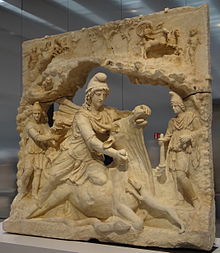
Back Mitraïsme Afrikaans المثرائية Arabic الاسرار الميثرانيه ARZ Mitraizm Azerbaijani Митраизъм Bulgarian Mithraisme BJN মিথ্রীয়ধর্ম Bengali/Bangla Mitraizam BS Mitraisme Catalan میتراییزم CKB



Mithraism, also known as the Mithraic mysteries or the Cult of Mithras, was a Roman mystery religion centered on the god Mithras. Although inspired by Iranian worship of the Zoroastrian divinity (yazata) Mithra, the Roman Mithras was linked to a new and distinctive imagery, and the level of continuity between Persian and Greco-Roman practice remains debatable.[a] The mysteries were popular among the Imperial Roman army from the 1st to the 4th century CE.[2]
Worshippers of Mithras had a complex system of seven grades of initiation and communal ritual meals. Initiates called themselves syndexioi, those "united by the handshake".[b] They met in dedicated mithraea (singular mithraeum), underground temples that survive in large numbers. The cult appears to have had its center in Rome,[3] and was popular throughout the western half of the empire, as far south as Roman Africa and Numidia, as far east as Roman Dacia, as far north as Roman Britain,[4](pp 26–27) and to a lesser extent in Roman Syria in the east.[3]
Mithraism is viewed as a rival of early Christianity.[5](p 147) In the 4th century, Mithraists faced persecution from Christians, and the religion was subsequently suppressed and eliminated in the Roman Empire by the end of the century.[6]
Numerous archaeological finds, including meeting places, monuments, and artifacts, have contributed to modern knowledge about Mithraism throughout the Roman Empire.[c] The iconic scenes of Mithras show him being born from a rock, slaughtering a bull, and sharing a banquet with the god Sol (the Sun). About 420 sites have yielded materials related to the cult. Among the items found are about 1000 inscriptions, 700 examples of the bull-killing scene (tauroctony), and about 400 other monuments.[4](p xxi) It has been estimated that there would have been at least 680 mithraea in the city of Rome.[8][full citation needed] No written narratives or theology from the religion survive; limited information can be derived from the inscriptions and brief or passing references in Greek and Latin literature. Interpretation of the physical evidence remains problematic and contested.[d]
- ^ Beck, Roger (20 July 2002). "Mithraism". Encyclopaedia Iranica (Online ed.). Retrieved 14 March 2011.
- ^ Cite error: The named reference
Geden-1925-2004was invoked but never defined (see the help page). - ^ a b Cite error: The named reference
hopfe-5was invoked but never defined (see the help page). - ^ a b
Clauss, Manfred (2000). The Roman Cult of Mithras: The god and his mysteries. Edinburgh University Press. ISBN 0-415-92977-6. ISBN 0-7486-1396-X - ^ Cite error: The named reference
Richardson-Hopfe-1994-Archeolwas invoked but never defined (see the help page). - ^ Cite error: The named reference
collectedworkswas invoked but never defined (see the help page). - ^ Beck, Roger (17 February 2011). "The pagan shadow of Christ?". BBC-History. Retrieved 4 June 2011.
- ^ Cite error: The named reference
HaaseTemporini1984was invoked but never defined (see the help page). - ^ Cite error: The named reference
Ulansey-1991-Originswas invoked but never defined (see the help page).
Cite error: There are <ref group=lower-alpha> tags or {{efn}} templates on this page, but the references will not show without a {{reflist|group=lower-alpha}} template or {{notelist}} template (see the help page).
© MMXXIII Rich X Search. We shall prevail. All rights reserved. Rich X Search